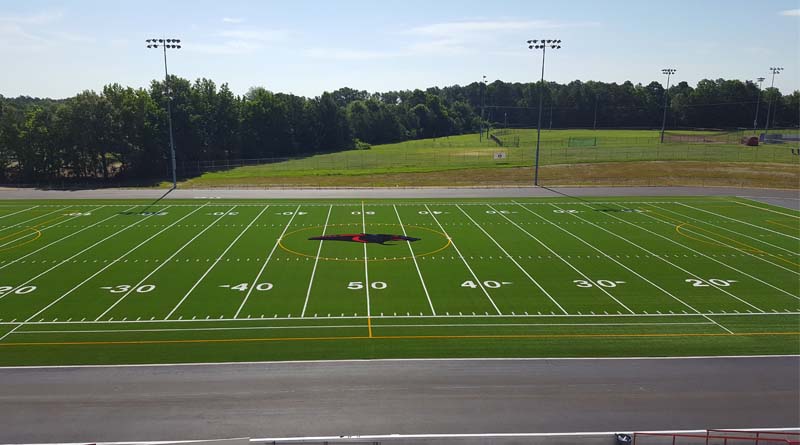By Justin Cornwell and Jeff Nelson
Sports has the power to unite diverse groups around a common goal. For schools at all levels, athletics can serve as a foundation for a school’s identity and is a crucial component of efforts to ensure healthy lifestyles.
The value of an athletics program goes beyond winning championships as schools increasingly rely on sports facilities and fields for myriad of functions. From practice time to game day and from intramural programs to sports tourism, sports fields are asked to do more than ever.
This expanded role of sports fields brings with it a number of challenges for schools, especially those school systems or institutions with natural grass fields. First, the cost to maintain these existing fields can increase year after year. Not only does the grass need consistent maintenance, but weather conditions can severely damage the field, requiring ongoing capital improvements.
Weather doesn’t just impact a field’s maintenance, it also can severely restrict the ability of a school to use the field. Grass fields that flood can’t be used for practices, games, or other events, forcing schools to cancel programming or find alternative and less desirable options. For example, poor field conditions at Hampton University caused flooding and erosion that prevented teams from practicing on the field and forced practices to move to an indoor gym during periods of heavy rain. A new synthetic field solved this issue so outdoor teams can play in various weather conditions, helping prepare them for upcoming games and freeing up the indoor gym for other programs. With demands for sport programming on the rise, all schools need to maximize their facilities, including sports fields.
Finally, a major challenge for existing natural grass fields is safety. Ensuring all participants are in a safe environment is the top priority for any school. Unfortunately, natural grass and older turf fields can result in harder surfaces with higher GMAX scores, a key consideration in potential concussions. Likewise, fields that flood easily can create uneven and unstable surfaces, resulting in more injuries.
Recognizing these serious concerns, more K-12 school systems and colleges and universities are exploring synthetic turf sports fields. Synthetic field technology has advanced exponentially in recent years and offer an array of benefits, especially when compared to natural grass fields.
Notably, synthetic fields can be more durable and multipurpose. The use of organic infill materials made with coconut husk, cork, corn husk, and other materials are a more widely accepted alternative to traditional crumb rubber infills. These materials may provide for softer surfaces as well as reduce the amount of heat trapped on a field. Improved shock pads are also installed underneath synthetic fields to further enhance safety. Vastly improved drainage of artificial fields further reduces maintenance costs and allows a field to be in use more often. For example, new synthetic turf fields installed at Henrico County, Virginia high schools can drain 12 inches of water per hour.
Henrico County offers a timely example of school districts recognizing the value of new synthetic turf fields. The county has initiated a multi-year phased project to replace the natural grass fields at its high schools with new artificial turf. The fields are designed and engineered to reduce maintenance, enhance safety, and ensure proper drainage. The field materials, site design, and underdrain systems all work together to create new synthetic sports fields that meet the county’s needs. In an innovative move, the county’s Department of Recreation and Parks to maintains the fields in an effort to streamline maintenance and ensure the new fields are leveraged for sports tourism and revenue-producing events.
College and universities see significant merit in these new fields as well. William and Mary, for example, installed synthetic turf on intramural fields at the college’s campus in Williamsburg, Virginia. This move now allows the college to program the field for additional hours and use it for a wide array of athletic events, including team practices and intramural programs. More opportunities to use these fields means that the college can offer additional athletic/recreational opportunities for students and maximize their investment in the synthetic fields.
That investment is an important consideration. Synthetic turf fields are more expensive to install than natural grass fields. However, the investment can be partially recouped through the decrease in long-term maintenance cost and the potential to generate revenue by renting the field for more uses. Many schools that face capital expenditures for their existing fields recognize the enduring investment in a new artificial field and long-term value that field brings. The initial capital investment can also be financed in many ways, including bonds, fundraising, and financing options from manufacturers.
Sports field design is about more than a set of plans; it is about creating the thrill inherent in competition and that feel of a game-winning moment. Engineering these experiences, made possible by superior athletic facilities and sports fields, involves a team approach. Increasingly, more K-12 school systems and colleges and universities are looking to synthetic fields to provide that experience and better results.
Justin Cornwell is a Project Manager and Jeff Nelson is a Business Development Manager with Draper Aden Associates, a Mid-Atlantic engineering, surveying, and environmental services firm. Draper Aden has led design and construction administration for dozens of sports fields for K-12 schools and college and universities.


